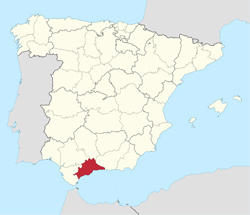Málaga in Málaga

 The province of Málaga in Andalucía is probably the best known Spanish province amongst Brits and many other Europeans. It is situated in the western end of the Spanish Mediterranean coast, bordering on fellow Andalucían provinces Cádiz, Seville, Córdoba and Granada.
The province of Málaga in Andalucía is probably the best known Spanish province amongst Brits and many other Europeans. It is situated in the western end of the Spanish Mediterranean coast, bordering on fellow Andalucían provinces Cádiz, Seville, Córdoba and Granada.
It is famous for its many bustling tourist resorts, sandy beaches, high rise hotels and lively nightlife.
Admittedly, the coastal area of the province, Costa del Sol, is where most people live, where most tourists visit and where most income is generated. But there are other aspects to the province as well.
Málaga province covers an area of 7,308 km2; a third of the territory is at 0-400 MASL, one third between 400 and 800 and one third between 800 and 2,000 MASL. The highest point in the province is at 2,066 MASL, a mountain peak called La Maroma.
The province has mountains, forests, scrublands and wetlands as well as its famous coast, and it is home to a large and varied wild life.
Several rivers traverse the province although excessive use of water has caused some of them to dry up over summer; almost all of them flow into the Mediterranean Sea.
The climate in Málaga is mild with hot summers and warm winters. Rainfall is highest in autumn and winter with an annual average of 534 mm. On the coast the temperature in summer often hits the late 30s in the day time and then drops to around 20 at night. The maximum temperatures at higher altitudes are more moderate.
Málaga province is home to 1.641 million (2018) souls, 574,626 (2019) of whom live in the capital of the same name. This makes it Spain’s 6th most populated city, the second in Andalucía and the 46th in Europe.
The city lies on the coast in the middle of a large bay and is backed by mountains to the north. Málaga is one of Europe’s oldest cities; the first colonial settlement dates back to between 800 and 500 BC; it was founded by the Phoenicians who colonised ‘Malaka’ for its silver and copper deposits.
The city followed the usual Spanish pattern of being conquered by first the Romans followed by the Visigoths, the Moors and finally the Catholic Monarchs.
It has been declared a historical site, and only few cities in the world offer such a wealth of evidence from past civilizations, both Eastern and Western, and in as great a concentration as in Malaga.
Some of the most outstanding monuments are the Roman Theatre, the Alcazaba, the Cathedral, the Palacio de la Aduana and the Jewish Quarter; and the city rests on a wealth of underground archaeological treasure.
Down by the sea front, flanked by impressive buildings such as the Palacio de la Aduana, the Town Hall and the offices of the Bank of Spain, amongst others, is Malaga Park, often simply known as ‘The Park’, which is a 1 kilometre long avenue with lots of features such as small statues, seating areas and paths. It was started in 1896 on land reclaimed from the sea, and it is populated by plants from the five continents which have been naturally adapted to Málaga and which make it a unique botanical park in Europe.
In the historic quarter, centred around the ficus lined Alameda Principal Avenue, there are several points of interest: the Casa de Guardia, an establishment where they have been serving Malaga wines for more than 150 years, or the house where the Danish poet and writer Hans Christian Andersen stayed during his visit to Malaga in 1862. The writer said about Málaga: ‘In none of the cities of Spain have I felt so happy, so comfortably at home, as in Málaga’.
His statue, sitting comfortably on a bench, can be found nearby.
Málaga is also the birthplace of Pablo Picasso, and there are several museums dedicated to this artist, who lived there until the age of ten.
Málaga is one of the most popular ports of call for Mediterranean cruises, and there are always several cruise ships to admire when you walk along the harbour.
Both the province and the city of Málaga are teeming with places of interest, picturesque villages and towns and beautiful countryside apart from a coastline second to none, and we have only just scratched the surface here.


